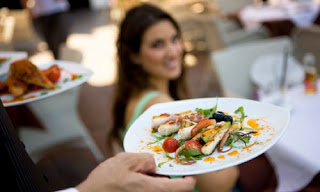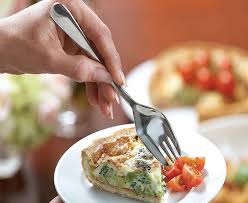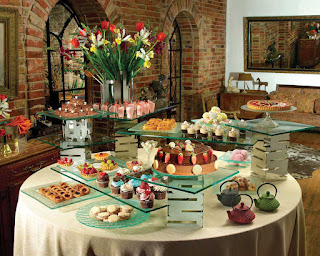METHODS OF FOOD SERVICE
Services of food & beverage in the Food and Beverage Operations can be carried out many ways. But during the method of service, certain factors have to be kept in mind which is as follows:-
1. The type of establishment
2. Time available for the meal
3. Turnover of customers expected
4. The cost of meal served
5. Site of the establishment
Some of the main methods of services are as follows:
ENGLISH SERVICE /SILVER SERVICE/ PLATTER TO PLATE SERVICE
This usually includes serving food at the table. It is a technique of transferring food from a service dish to the guest's plate from the left. Food is placed in the serving platters by the chef and transferred on to the plate to the guest by the waiter. It is a highly personalized service which adds to good will. It gives the guest the choice of selecting and quantifying the food served to him. However skilled waiters are required for silver service. In addition to this high capital investment, maintenance cost is involved as silver service requires a great attention and care.
Following are the disadvantages of silver service-
• When last portion is served, the food on the platter looks scattered and unappetizing. Even portions can be miscalculated, ending up in giving more or less to the last guest due to uneven distribution of food. After the service the platters and service gear gets piled up on the sideboard.
• Time consuming
• Difficult to maintain the service temperature of the food
• Service charge is generally high
• High capital investment
AMERICAN SERVICE/ PRE-PLATED SERVICE
Method of serving food in which the food are placed on plates in the kitchen by the chef and is served to the guests by the waiter/waitress from the right side of the guest.It is quick and simple service which involves less capital investment, labour and maintenance cost. Garnishes are maintained on individual portions, which don’t involve much skill.
BUTLER SERVICE
The English word “butler” is derived from the Middle English Word “Boteler” from old French “bouteiller” (bottle bearer) and before that from Middle Latin “Butticula”.
Gradually, throughout the 19th century and particularly the Victorian era, as the number of butlers and other domestic servants greatly increased in various countries , the butler became a senior male servant of a household’s staff.
Butler is involved in helping the host to conduct the service smoothly. Platters and entrée dishes are brought on trolley and kept before the host to portion out all the items. Often the butler and the assistants take the platters around for second helping. It is also called Family Style service. It is a very private type of service which doesn’t exceed ten to fifteen guests.
The definition of the term guerdon is a movable service table, or trolley, from which food is carved, filleted, flamed and served. This may include serving foods that have to be prepared and served or simply food that is being served from the guerdon. In other words, it is movable side board carrying sufficient equipment for the service requirements, together with any spare equipment that may be necessary.
Gueridon service is normally found in high class establishments with an a la carte menu. It is more expensive as it requires a higher level of service skills, more elaborate and expensive equipment and a larger area for the movement of trolleys.
Flambé dishes first became popular in Britain during the Edwardian era. Crepe suzette claims to be the first flambé dish, which supposedly was invented by Henri Charpentier when as a commis at the Café de Paris in Monte Carlo in 1894. Common Guéridon trolleys are-
(a) The Flambé trolley
(b) The Pastry trolley
(c) Hors d’ oeuvre trolley
(d) Carving trolley
ADVANTAGE
1. Display of dishes- Pastries, Carving, etc.
2. The showmanship and expertise act of the service personnel is brought forward.
3. Impulse buying.
4. Cost is minimum – Great returns.
DISADVANTAGE
1. SPACE REQUIREMENT
2. SAFETY
3. INITIAL COST IS HIGH
4. HIGHLY SKILLED STAFF
BUFFET SERVICE
The word “buffet” is a French word which means a refreshment table which in English means “service from a side table”.
In this type of service the food is placed on a common table from which the guest can help themselves. It is a common method of feeding a large number of people with minimal staff in a short span of time. The option of unlimited portion makes the buffet style popular.
Types of buffet
Sit down buffet
• Space requirement is more.
• Dishes are displayed and guest help themselves or assisted service is there.
• Common for both informal and formal function.
• Popular for wedding reception.
Standing buffet
• Where space is minimum this type of buffet is ideal.
• People stand and consume their meal. Popular in case of dealers meet etc.
Fork buffet
• Simply where flat ware is used.
• When people stand and eat, it is not convenient to use knife, hence fork is convenient to use.
• All food items should be manageable with a fork i.e. large slices of meat or fish is not suitable
Finger buffet
• No cutlery is required
• Ideal for Indian food and finger buffet is popular for wedding reception
• Popular in smaller establishment and outdoor catering.
Cold buffet
• Display of cold cuts and cold hors’d oeuvre are served.
• Popular in the western world.
Display buffet
• Display of ice carving , tallow sculpture, butter sculpture (center piece)
• Salad display
• Live counter
• Tawa counter
• Japanese teypanyaki (live counter)
• Chinese/Thai live counter.
• Carving and flambé items.
Buffet service is normally carried out from a chaffing dish. The various parts of a chaffing dish include a stand, food pan, water pan, and lid and fuel pot.
Advantages
• Fast service.
• Variety of dishes can be served.
• High profit and low food cost.
• Less skilled manpower.
• Economically priced
Disadvantages
• Impersonalized service.
• Portion control may not be improvised.
• Standardization of dishes is not possible.
• Elaborately garnished dishes can’t be served.
• Initial cost is high
• Breakage is more
RUSSIAN SERVICE
This type of service has come from the era Tsar of Russia who believed in show. The basic element in Russian service derives from the old style of having large joints, whole fish or birds often decoratively placed on platters with elaborate garnishes on the sideboard visible to the guests before being served. The food is then collected on smaller platters by the waiter and served to guest on the table just as in silver service. This form of service enjoyed slight popularity in Europe in the 19th century otherwise Russian Service as a distinct and separate form of service no longer remains.
CAFETERIA SERVICE
In a cafeteria service mostly cooked food is arranged behind a food serving counter. There is no or little table service. Typically a patron takes a tray and pushes it along a track in front of the counter. Depending on the establishment servings may be ordered from attendants, selected as ready made portions already on plates, or self service of food of their own choice.
In some establishments, a few items such as steaks may be ordered and the patron waits for those items to be prepared or is given a number and is brought to the table.
Beverages may be filled from the self service dispensers or ordered from the attendants. At the end of the line the patron has to pay to the cashier in case of commercial establishments. At some self service cafeterias, purchases are priced by weight rather than individual item.
The trays with selected items or food are taken to a table to eat. Institutional cafeteria may have a common table, but upscale cafeteria provides individual table as in sit down service restaurants. Upscale cafeteria has traditional cutlery and crockery and some have servers carrying the food tray to the table or clearing the used and empty trays.
Cafeteria is a Spanish word meaning coffeehouse though it has no relation with cafeteria service. It might have a single or multiple point entry.

















No comments:
Post a Comment